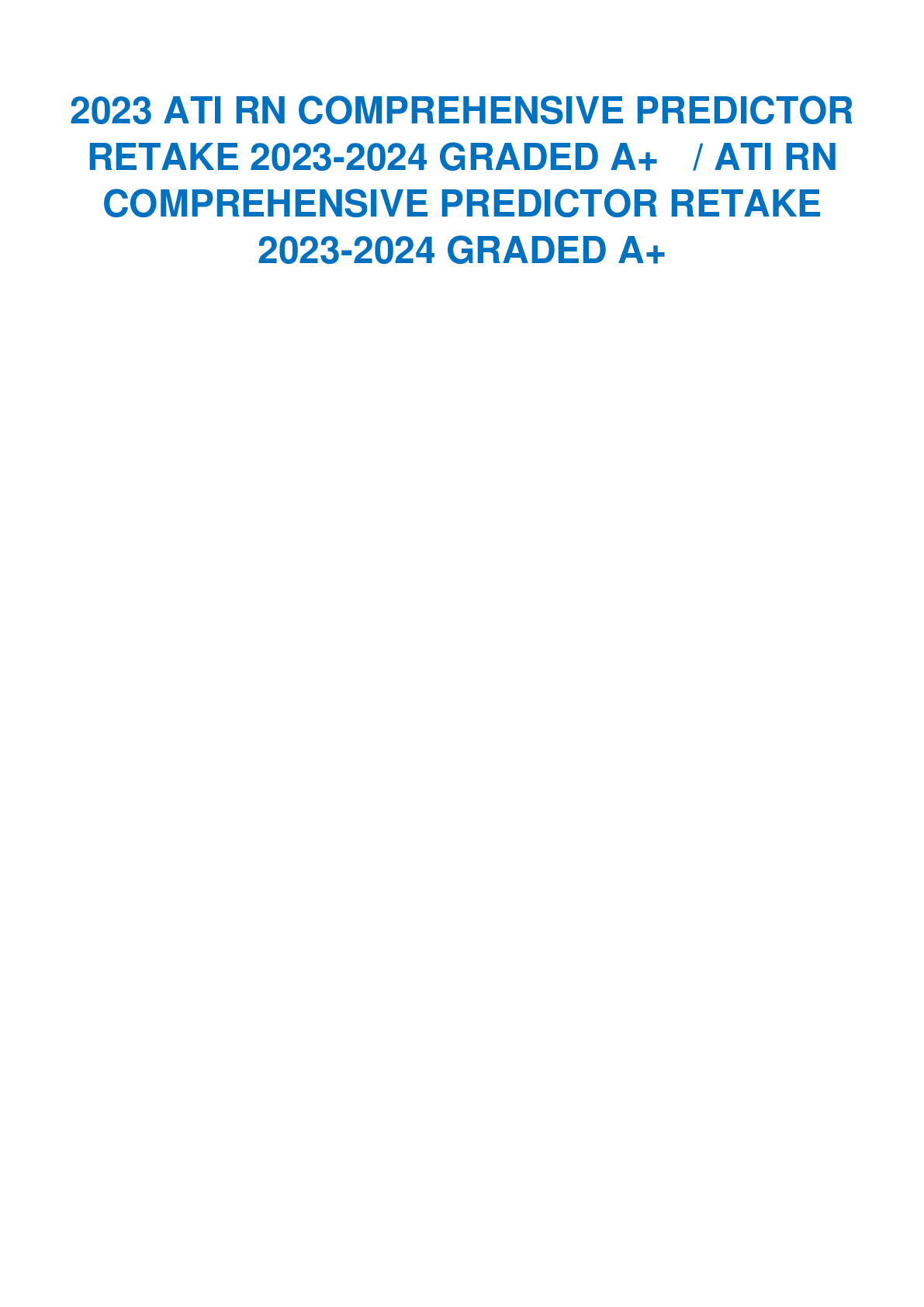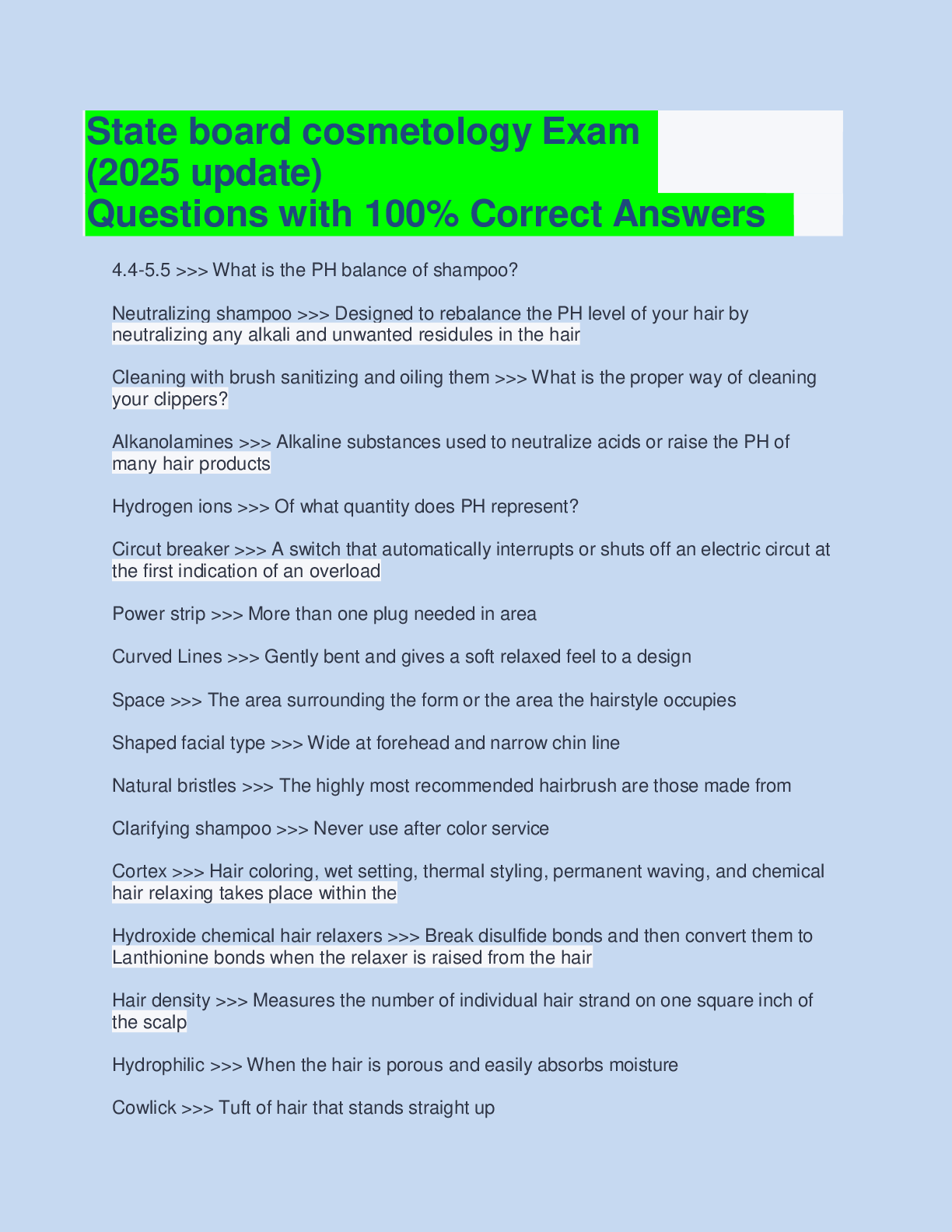Education > QUESTIONS & ANSWERS > NUR 3065 Physical Assessment in Health Care Quiz 6 | 40 Q&A Graded A (All)
NUR 3065 Physical Assessment in Health Care Quiz 6 | 40 Q&A Graded A
Document Content and Description Below
NURSING NUR 3065 Physical Assessment in Health Care- Quiz 6 • Question 1 2.5 out of 2.5 points You are performing a physical examination on a 46-year-old male patient. His examinati... on findings include the following: positive peripheral edema, holosystolic murmur in the tricuspid region, and a pulsatile liver. His diagnosis is: • Question 2 2.5 out of 2.5 points You are performing jugular venous pressure measurement for your patient in heart failure. You see a pulse wave with the patient’s head elevated at a 45-degree angle. Your action as a result of this assessment is to: • Question 3 2.5 out of 2.5 points Which of the following statements is true regarding the development of venous ulcers in older adults? b. Diabetes, peripheral neuropathy, and nutritional deficiencies are causative factors. • Question 4 2.5 out of 2.5 points Which arterial pulse is most useful for evaluating heart activity? • Question 5 2.5 out of 2.5 points You are examining Mr. S, a 79-year-old diabetic man complaining of claudication. Which of the following physical findings is consistent with the diagnosis of peripheral arterial disease? • Question 6 2.5 out of 2.5 points Which of the following statements is true regarding the examination of peripheral arteries? • Question 7 2.5 out of 2.5 points You are palpating bilateral pedal pulses and cannot feel one of the pulses. The feet are equally warm. You find that both great toes are pink, with a capillary refill within 2 seconds. Which of the following statements is correct? • Question 8 2.5 out of 2.5 points Which of the following are risk factors for varicose veins? (Select all that apply.) • Question 9 2.5 out of 2.5 points You are assessing Mr. Z’s fluid volume status as a result of heart failure. If your finger depresses a patient’s edematous ankle to a depth of 6 mm, you should record this pitting as: • Question 10 2.5 out of 2.5 points Which of the following statements is most accurate in describing hepatojugular reflux? • Question 11 2.5 out of 2.5 points Which of the following arteries provides blood supply to the breast? • Question 12 2.5 out of 2.5 points Which of the following muscles form the floor of the breast? (Select all that apply.) • Question 13 2.5 out of 2.5 points You are conducting a clinical breast examination for your 30-year-old patient. Her breasts are symmetric, with bilateral, multiple tender masses that are freely moveable and with well-defined borders. You recognize that these symptoms and assessment findings are consistent with: • Question 14 2.5 out of 2.5 points Which finding, on inspection, is related to fibrotic tissue changes that occur with breast carcinoma? • Question 15 2.5 out of 2.5 points Which of the following is a common benign variation in the breasts of a pregnant woman? • Question 16 2.5 out of 2.5 points You are performing a clinical breast examination for a 55-year-old woman. While palpating the supraclavicular area, you suspect that you feel a node. To improve your hooked technique, you should: • Question 17 2.5 out of 2.5 points While examining a 30-year-old woman, you note that one breast is slightly larger than the other. In response to this finding, you should: • Question 18 2.5 out of 2.5 points While collecting personal and social history data from a woman complaining of breast discomfort, you should question her regarding her: • Question 19 2.5 out of 2.5 points Your patient is a nursing mother who asks you to look at a mole she has under her left breast at the inframammary fold. The mole is nontender and soft and has grown in size since she started nursing. There are no other changes to the mole. This mole probably represents an undiagnosed: • Question 20 2.5 out of 2.5 points Which of the following is most likely to be a variation of minor consequence? • Question 21 2.5 out of 2.5 points Which of the following is true regarding the stomach? • Question 22 0 out of 2.5 points You are examining the abdomen of a 45-year-old female patient. When percussing her urine-filled bladder, you will hear _______________ tones. • Question 23 2.5 out of 2.5 points Your patient returns to the office with multiple complaints regarding her abdomen. Which of the following are objective findings? (Select all that apply.) • Question 24 2.5 out of 2.5 points Your patient is a 48-year-old woman with complaints of severe cramping pain in the abdomen and right flank. Her past medical history includes a history of bladder calculi. You diagnose her with renal calculi at this time. Which of the following symptoms would you expect with her diagnosis? (Select all that apply.) • Question 25 0 out of 2.5 points You are completing a general physical examination on Mr. Rock, a 39-year-old man with complaints of constipation. When examining a patient with tense abdominal musculature, a helpful technique is to have the patient: • Question 26 2.5 out of 2.5 points Which structure is located in the hypogastric region of the abdomen? • Question 27 2.5 out of 2.5 points Which organs have both an excretion function and function as endocrine glands? • Question 28 2.5 out of 2.5 points Which of the following organs is part of the alimentary tract? • Question 29 2.5 out of 2.5 points Your patient presents with symptoms that lead you to suspect acute appendicitis. Which assessment finding is least likely to be associated with this condition? • Question 30 2.5 out of 2.5 points Your patient is complaining of acute, intense, sharp epigastric pain that radiates to the back and left scapula, with nausea and vomiting. Based on this history, your prioritized physical examination should be to: • Question 31 2.5 out of 2.5 points Which of the following information belongs in the past medical history section related to heart and blood vessel assessment? • Question 32 2.5 out of 2.5 points Your patient, who abuses intravenous (IV) drugs, has a sudden onset of fever and symptoms of congestive heart failure. Inspection of the skin reveals nontender erythematic lesions to the palms. These findings are consistent with the development of: • Question 33 2.5 out of 2.5 points You are conducting an examination of Mr. Curtis’s heart and blood vessels and auscultate a grade III murmur. The intensity of this murmur is: • Question 34 2.5 out of 2.5 points Which two structures together form the primary muscle mass of the heart? • Question 35 2.5 out of 2.5 points Which one of the following is a common symptom of cardiovascular disorders in the older adult? • Question 36 0 out of 2.5 points Your patient has been diagnosed with pericarditis. Which of the following are signs and symptoms, or a precipitating factor?(Select all that apply.) • Question 37 2.5 out of 2.5 points Which cardiac structure is responsible for the heart’s pumping action? • Question 38 2.5 out of 2.5 points Which dysrhythmia is a physiologic event during childhood? • Question 39 2.5 out of 2.5 points You are listening to a patient’s heart sounds in the aortic and pulmonic areas. The sound becomes asynchronous during inspiration. The prevalent heart sound in this area is most likely: • Question 40 2.5 out of 2.5 points Which two heart chambers are most anterior in the chest? [Show More]
Last updated: 1 month ago
Preview 1 out of 7 pages

Buy this document to get the full access instantly
Instant Download Access after purchase
Buy NowInstant download
We Accept:

Reviews( 0 )
$8.00
Can't find what you want? Try our AI powered Search
Document information
Connected school, study & course
About the document
Uploaded On
Aug 30, 2019
Number of pages
7
Written in
Additional information
This document has been written for:
Uploaded
Aug 30, 2019
Downloads
0
Views
309

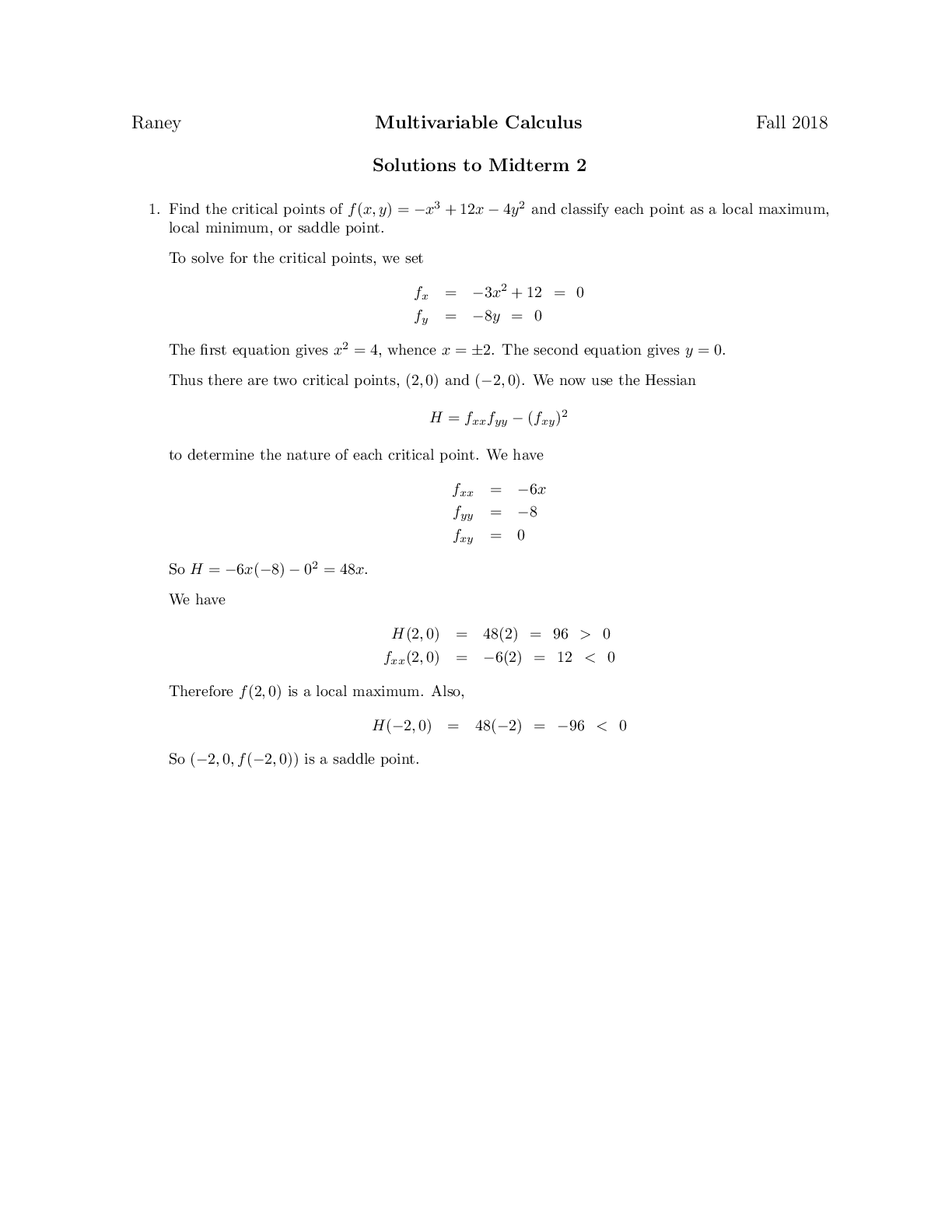


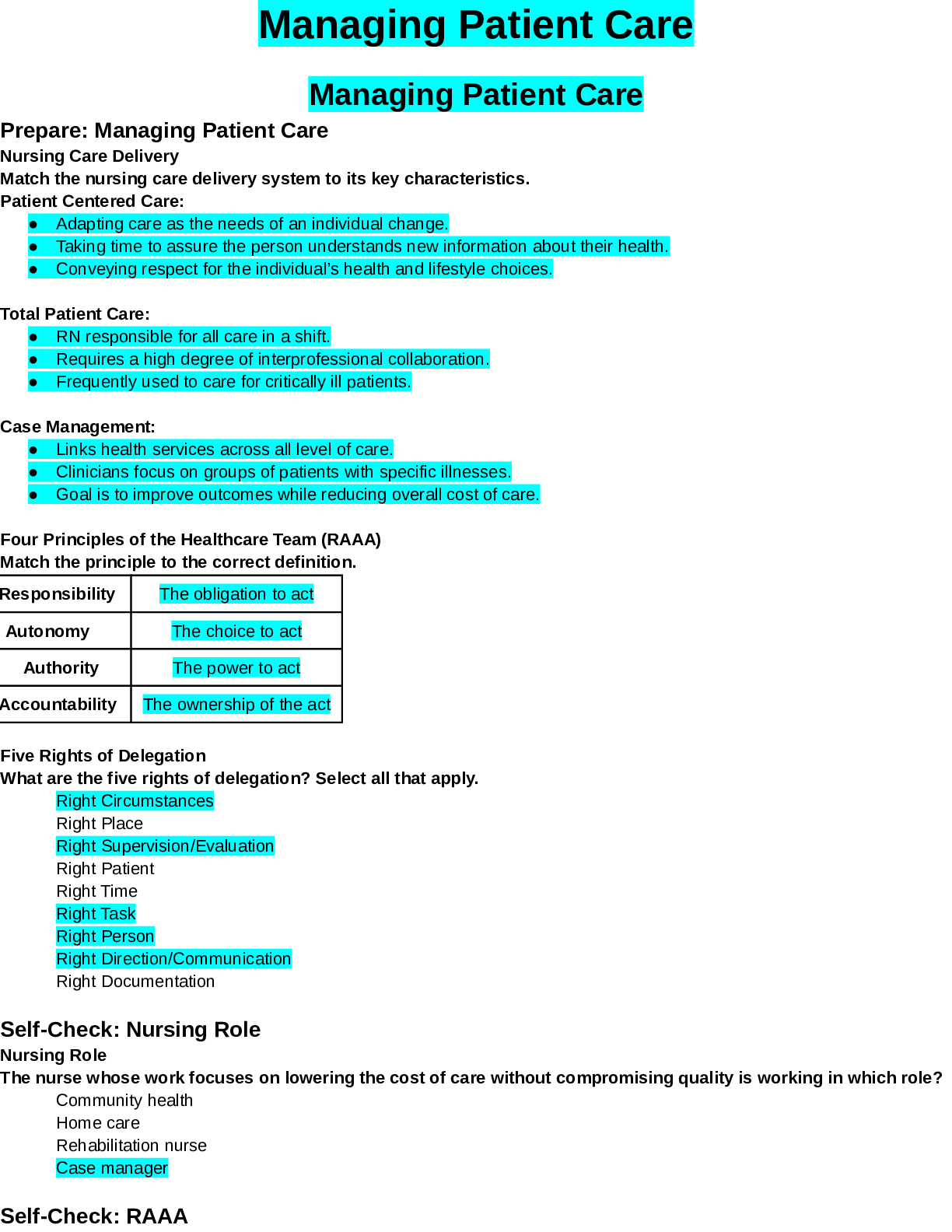




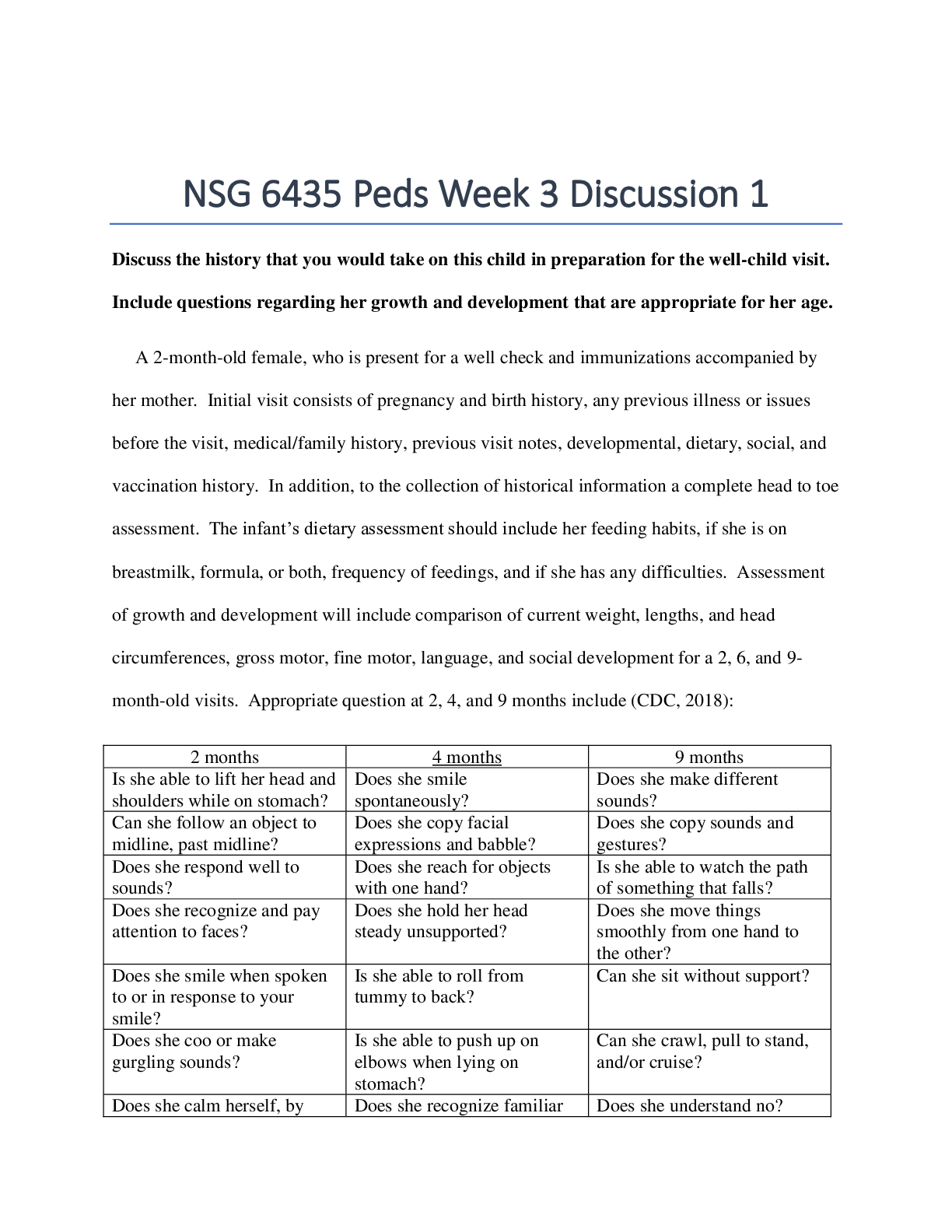
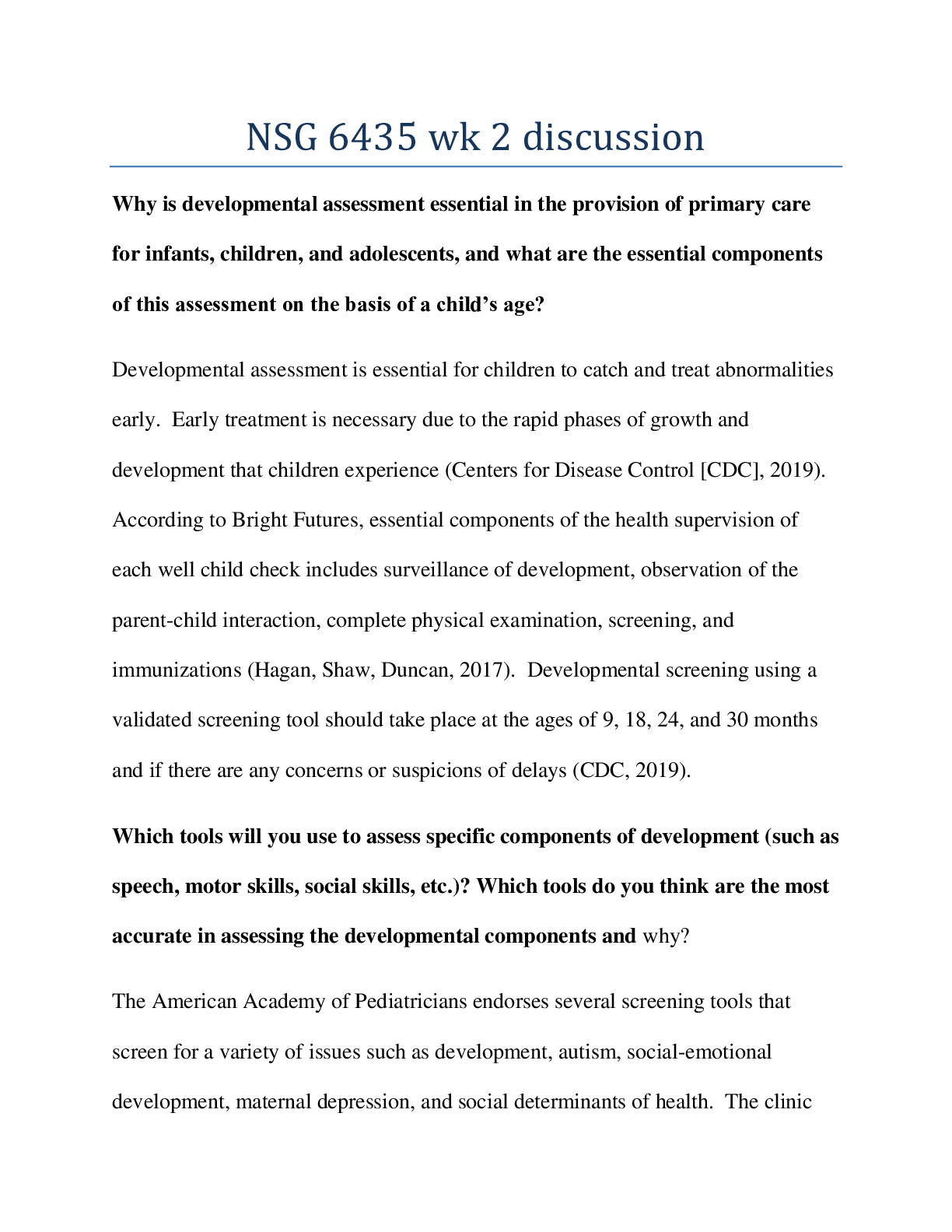
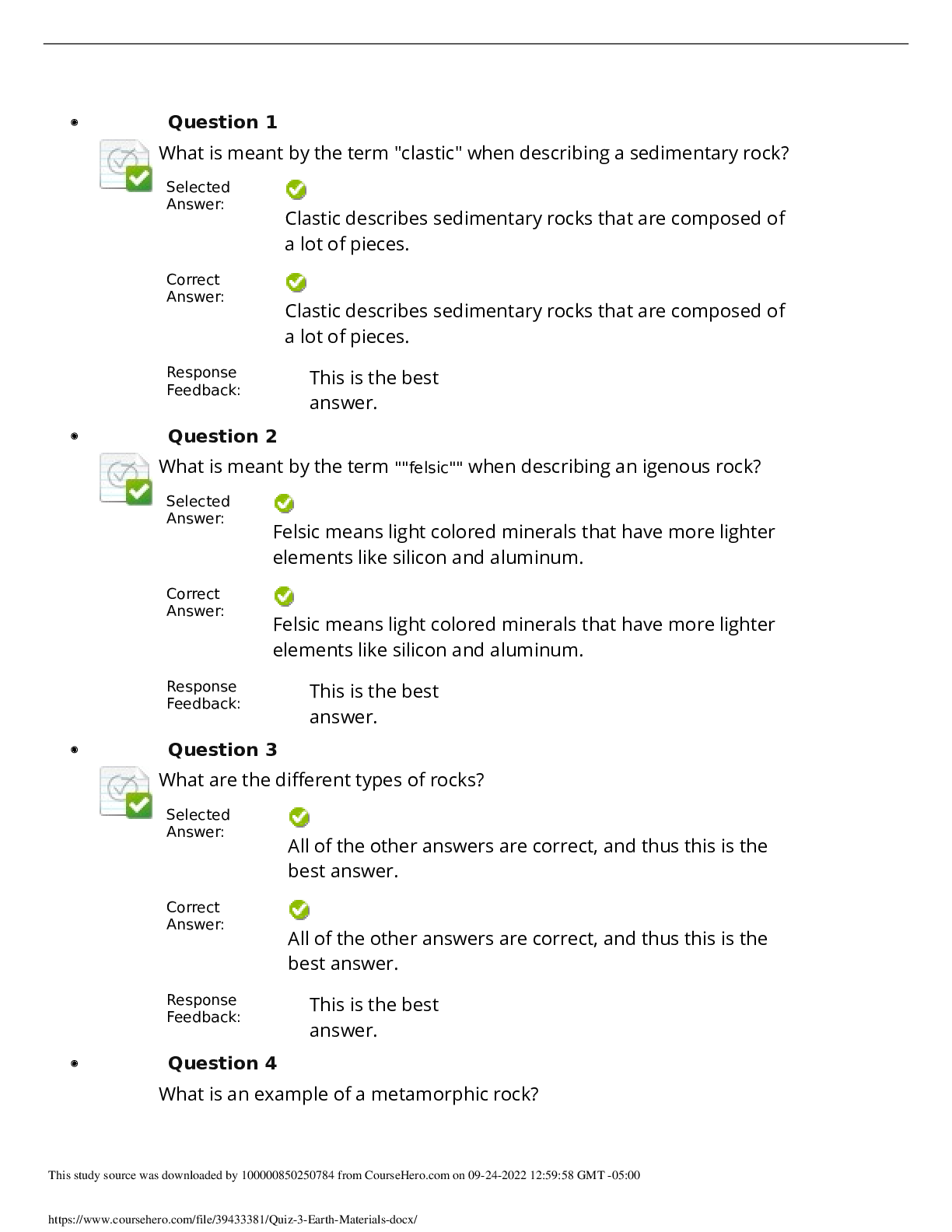
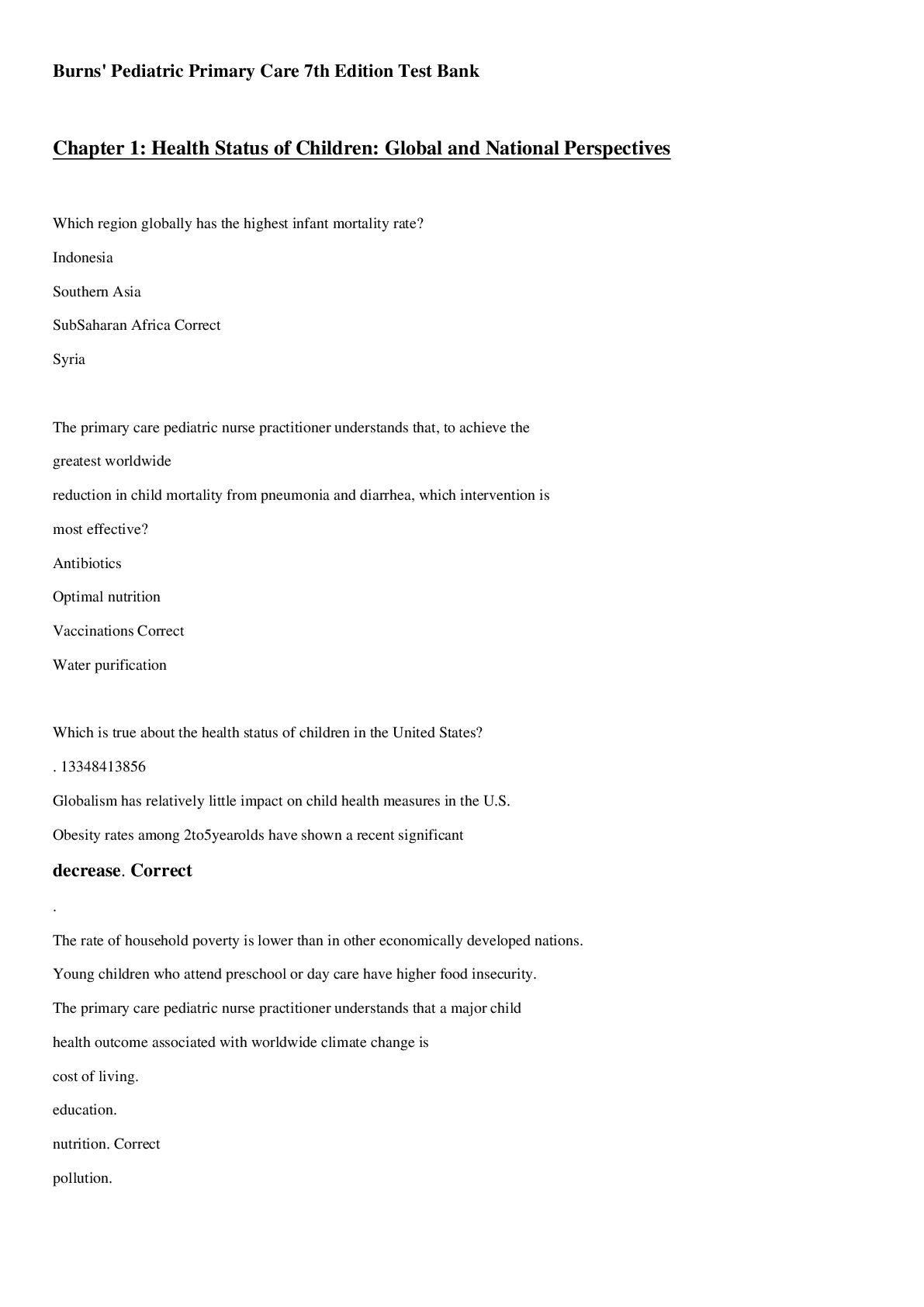



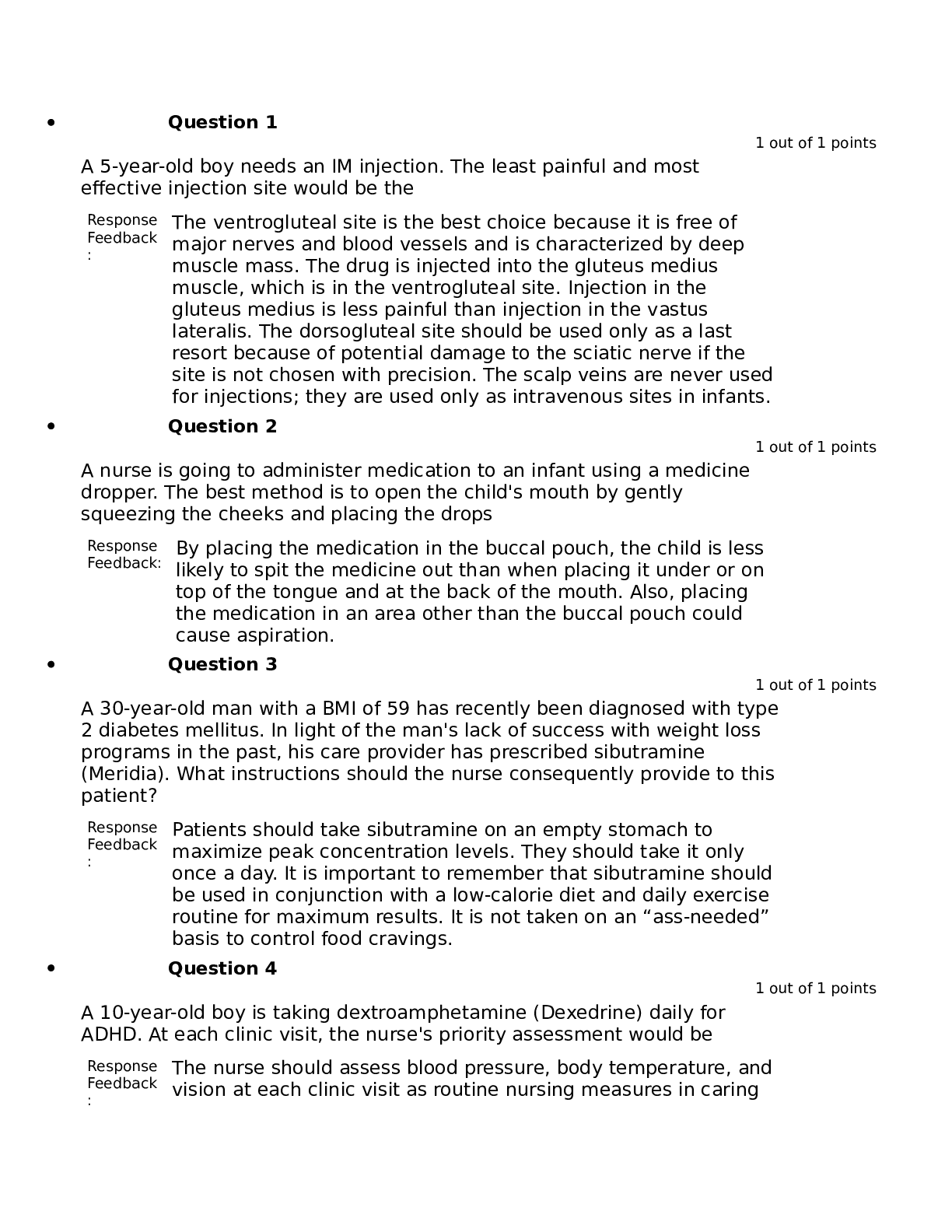

.png)
